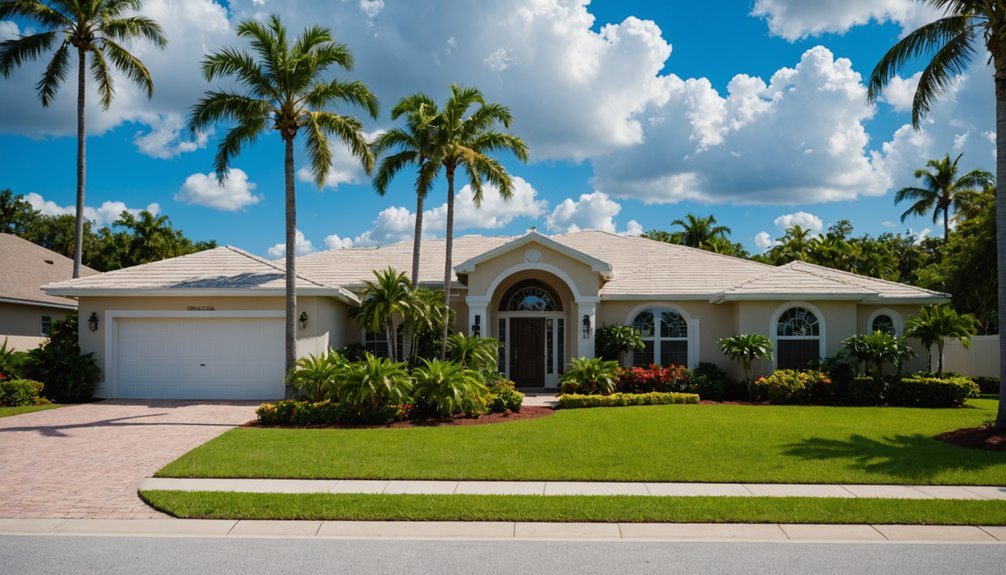Selling a home quickly in Florida is crucial due to the state’s rapid population growth, projected to reach 23.36 million by 2025, which drives intense housing demand. With inventory rising to 181,822 listings and a buyer’s market, timing is critical to avoid prolonged sales cycles. Competitive pricing and strategic staging can capitalize on buyer preferences for quick move-ins and amenities. Investigate further to uncover key strategies for maneuvering this dynamic market. For more insights, check out our Sell Home Fast Florida Tips.
Sell Homes Fast in Florida with Morgando Realty ServicesKey Takeaways
These ‘Sell Your Home Fast in Florida’ Tips will guide you through the essentials of a quick and successful sale.
- Selling fast in Florida capitalizes on high demand from population growth projected at 23.36 million by 2025.
- Quick sales help avoid the risks of price corrections in overvalued markets, such as Palm Beach County.
- Rapid transactions leverage buyer preferences for quick move-in resale homes in urban areas.
- Fast-selling counters are rising inventory, with a 7.5-month supply shifting buyers into a buyer’s market.
- Timely sales maximize returns before median home prices potentially drop further to $415K.
Florida’s Population Boom Creates Unprecedented Opportunities
Florida’s remarkable population surge, with an estimated 23.36 million residents by April 2025, presents a prime opportunity for homeowners seeking to sell their properties quickly. This growth, driven by a 467,347-person increase from 2023 to 2024 and fueled by migration and economic shifts, intensifies housing demand across urban centers like Orlando and Tampa. For those keen to join this thriving community, now is the time to act with strategy. Florida’s status as the fastest-growing state, with an 8.24% increase from 2020 to 2024, further underscores the importance of sellers acting promptly.
The increased inventory levels in Sarasota provide more options for buyers and signal the need for competitive pricing strategies to attract interest. Positioning a property in high-growth areas, such as St. Johns County or Port St. Lucie, can attract enthusiastic buyers. Highlighting proximity to booming metro hubs can seal deals swiftly. With housing needs outpacing supply, sellers who price competitively and market effectively can capitalize on this extraordinary demand, becoming a vital part of Florida’s vibrant future.
Navigating Rising Inventory Challenges
Increasingly, homeowners in Florida face the challenge of navigating a market with rising inventory levels, as active listings soared to 181,822 in May 2025, the highest level in over two years. With a 28.8% year-over-year surge in single-family home inventory and a 7.5-month supply statewide, sellers face a buyer’s market where options abound, and urgency has waned. Buyers now take longer to decide, prioritizing value and functionality, which shifts negotiation advantage in their favor. To stand out, sellers should focus on strategic differentiation through staging, energy-efficient upgrades, and targeted marketing of local amenities. By embracing data-driven pricing and flexible terms, homeowners can connect with discerning buyers and establish a strong presence in this competitive landscape. Additionally, with the median home price stabilizing at $409,600 in April 2025, sellers need to price competitively to attract buyers in this shifting market. Incorporating home staging techniques can significantly improve a property’s appeal, ultimately leading to a quicker sale.
Addressing Regional Price Disparities
Across Florida, stark regional price disparities complicate the home-selling process, demanding strategic awareness from sellers. Metropolitan areas like Coral Gables boast over 30% price increases, while Florida’s coastal counties suffer declines of 11% for single-family homes, Tampa’s. Tampa’s median price dipped 1.2% to $ 410,000, while Jacksonville’s median price rose. Port St. Lucie homes, overvalued by 41%, highlight affordability pressures against a median household income of $62,000. Miami’s inventory constraints drive 7.6% year-over-year growth. Understanding the importance of competitive listing prices is essential for attracting buyers in this fluctuating market.
Sellers must navigate these extremes, from fromlining affordability to Chto Char’s movements. Understanding these regional nuances is crucial for pricing competitively and effectively connecting with buyers. Additionally, with inventory levels at a 12-year high, sellers face increased competition to attract potential buyers. In this diverse market, aligning with local trends fosters a sense of community and guarantees a faster, smarter sale.
Adapting to Shifting Buyer Preferences
Sellers in Florida must recognize that, beyond regional price disparities, understanding evolving buyer preferences is key to securing a sale today. Today’s buyers prioritize amenity-rich communities with pools, clubs, and security features like gated access, which fosters a sense of belonging and safety. Quick move-in options, such as resale or recently built homes, appeal to those seeking to avoid construction delays, while staging vacant properties can expedite offers. Regular inspections of HVAC systems and energy-efficient upgrades can further enhance the appeal of luxury properties in markets like Miami, which attracts international buyers with high-end finishes and beachfront allure. Moreover, properties with rental potential in urban zones like Tampa draw investors seeking community ties and steady returns. By aligning with these preferences, sellers meet buyers’ desires for lifestyle and stability, ensuring a faster and more successful transaction. Additionally, with the growing demand for sustainable features, sellers who highlight energy-efficient upgrades can attract buyers looking for long-term cost savings.
Leveraging Economic and Rate Trends

Navigating the Florida housing market requires a keen understanding of economic trends and interest rate fluctuations that influence buyer behavior. With mortgage rates projected to dip to 6.3% by late 2024, affordability may improve, subtly easing homeownership costs even if sales volume remains steady. However, sustained high rates since 2022 have tempered demand, while builders offer rate buy-downs to attract buyers. Meanwhile, home prices continue their ascent, with medians expected to reach $420,000 by 2025, further reassuring affordability. Florida’s population growth, projected to exceed 25 million by 2030, continues to drive daily demand for housing. Understanding market nuances can provide sellers with a strategic edge in this evolving landscape.
Sellers who act swiftly can capitalize on these dynamics, aligning themselves with a community of proactive homeowners. As inventory rises to 5.6 months, buyers gain an advantage, making now a strategic moment to sell before market shifts intensify competition. Join the savvy sellers maneuvering these trends.
Targeting Strategic Growth Locations
While navigating Florida’s dynamic real estate market, identifying strategic growth areas emerges as a critical tactic for maximizing a home’s selling potential. Sellers can capitalize on areas like Westlake, which boasts a staggering 21.57% annualized growth rate, or Leesburg, the third-fastest-growing city in the U.S., with an 18% growth rate from 2023 to 2024. Regions such as Polk County, with hotspots like Davenport and Haines City, and Marion County, featuring communities like Rainbow Park, offer robust demand and a sense of community that appeals to prospective buyers. Additionally, focusing on metro areas like Wildwood-The Villages, with nearly 5% growth in 2023, can attract buyers seeking vibrant, expanding communities. Understanding the probate process is also crucial for sellers dealing with inherited properties, as it can significantly impact the timing and method of sale.
| Location | Growth Rate | Key Appeal |
|---|---|---|
| Westlake (Palm Beach) | 21.57% | Rapid population expansion |
| Leesburg (Lake Co.) | 18% | Fastest-growing U.S. city |
| Davenport (Polk Co.) | 10.58% | Strong housing demand |
| Haines City (Polk Co.) | 7.70% | Community growth |
| Rainbow Park (Marion) | 7.16% | Active adult communities |
Mitigating Risks in Overvalued Markets
In Florida’s overvalued markets, sellers must prioritize avoiding price correction losses,as analysts predict gradual declines by 2026 in areas with inflated valuations. Steering through inventory surplus challengesis similarly critical, notably in regions with oversupply where unrenovated homes linger on the market for months. Timing a strategic market exitcan enhance returns, specifically by listing before insurance costs spike and buyer demand further erodes value. Additionally, with Southeast Florida homes deemed 15.4% overvalued, sellers face heightened risks if they delay listing in a cooling market. Understanding the real estate marketlandscape can help sellers make informed decisions about timing and pricing.
Avoiding Price Correction Losses
How can Florida homeowners safeguard their investments in a cooling genuine estate market? With median home prices dropping 3% year-over-year to $415K and markets like Tampa facing a 4.1% decline, the risk of price corrections looms large. Overvalued areas, such as Miami ($560,000) and Fort Lauderdale ($530,000), are particularly vulnerable, compounded by high mortgage rates near 7% and affordability pressures. Sellers must act decisively, aligning pricing with local trends—condo markets, for instance, show steeper declines across 19 of 22 metros. By prioritizing quick sales through strategic pricing or incentivized offers, homeowners can avoid deeper losses. Utilizing a pre-appraisal checklist ensures comprehensive preparation and can enhance negotiation power, enabling sellers to better position their homes in a challenging market. Joining a community of proactive sellers ensures protection against forecasted declines through 2026, securing financial stability in an uncertain landscape.
Homeowners must navigate this surplus by pricing accurately to avoid prolonged sales cycles. Offering incentives, such as closing cost assistance, can attract discerning buyers who now hold greater negotiating power. Leveraging local expertise is vital, as regional variations—such as a5.6-months’.6-months’ supply for single-family homes—demand tailored strategies. By aligning with market realities, sellers can confidently join a community of savvy homeowners overcoming these challenges.
Timing Market Exit Strategically
Why should Florida’s markets act with urgency when planning their exit? In regions like Palm Beach County, where homes are 15% overvalued, persistent demand-supply imbalances signal potential risks. Coastal cities like Miami face distinct pressures, while inland areas, such as Lakeland, grapple with a 60% surge in inventory, which is stalling price increases. With mortgage rates near 7% curbing buyer demand and new construction adding competition, delaying a sale could mean diminished returns.
Strategic timing offers a shield against these vulnerabilities. Listing during peak demand in spring or summer, particularly for renovated properties, can secure faster sales. By pricing competitively and acting proactively, sellers join a savvy community that navigates market shifts with confidence, protecting their financial interests in Florida’s dynamic landscape.
Frequently Asked Questions
How Do Property Taxes Impact Home Sales?
Property taxes greatly influence home sales by affecting affordability and net proceeds. Higher taxes can deter buyers and reduce seller gains, while looming increases often push transactions, impacting market dynamics across communities.
What Are Closing Costs for Sellers?
Cleverly calculating closing costs, sellers confront essential charges. These encompass commissions, typically 6-9% of the sale price, transfer taxes, and title fees. Join the savvy circle; understand these expenses to secure successful transactions.
How Does Home Staging Affect Speed?
Home staging notably accelerates sales speed by enhancing buyer appeal. Staged properties attract more visits, simplify visualization, and reduce market time, ensuring sellers connect with enthusiastic buyers in a competitive, genuine estate landscape.
Are There Legal Requirements for Disclosure?
Over 80% of Florida home sales involve disputes related to disclosures. Sellers are required by law to disclose any known material defects, such as foundation issues, under Florida Statutes. Join a trusted community by ensuring transparency and avoiding legal pitfalls.
What Role Do Realtors Play in Sales?
Real estate agents play a pivotal role in sales, expertly steering inventory trends, pricing strategies, and negotiations. Their market analysis and tailored advice guarantee that sellers and buyers connect, fostering successful transactions within a competitive community landscape.
Conclusion
To summarize, selling a home swiftly in Florida remains a strategic move for homeowners. The state’s population is surging by over 1.9% annually—among the highest in the nation—demand continues to drive a competitive market. Acting promptly allows sellers to capitalize on this growth, navigate inventory challenges, and mitigate risks in fluctuating regions. By leveraging current trends and targeting high-demand areas, sellers can secure ideal outcomes in Florida’s dynamic real estate landscape.
References
- https://www.bcpmortgage.com/post/florida-housing-market-trends-2025
- https://movingtofloridaguide.com/understanding-the-florida-real-estate-market-from-the-experts.html
- https://www.hco.com/insights/florida-housing-market
- https://www.youtube.com/watch?v=93URxqhCI_E
- https://www.youtube.com/watch?v=TtCBqTiNiJg
- https://edr.state.fl.us/content/conferences/population/demographicsummary.pdf
- https://www.clickorlando.com/news/local/2025/06/26/florida-is-the-fastest-growing-state-over-the-last-4-years-census-says-what-should-people-know-about-moving-here/
- https://northamericancommunityhub.com/florida-population-boom/
- https://www.aterio.io/insights/us-population-forecast/fl
- https://edr.state.fl.us/content/population-demographics/data/MediumProjections_2020.pdf







